K3PGP.Experimenter's.Corner
![]()
K3PGP.Experimenter's.Corner
![]()
Home Astronomy Bicycle Construction Laser Moonbounce Software Guest Misc Sales
Reprented with permission
http://bicyclesafe.com/
This page shows you real ways you can get hit and real ways to avoid them. This is a far cry from normal bicycle safety guides, which usually tell you little more than to wear your helmet and to follow the law. But consider this for a moment: Wearing a helmet will do absolutely nothing to prevent you from getting hit by a car! Sure, helmets might help you if you get hit, and it's a good idea to wear one, but your #1 goal should be to avoid getting hit in the first place. Plenty of cyclists are killed by cars even though they were wearing helmets. Ironically, if they had ridden without helmets, yet followed the guidelines listed below, they might still be alive today. Don't confuse wearing a helmet with biking safely. An ounce of prevention is worth a pound of cure. It's better to not get hit. That's what real bicycle safety is about.
As for following the law, most people are already aware that it's stupid to race through a red light when there's cross traffic, so the "follow the law" advice isn't that helpful because it's too obvious. What you'll find here are several scenarios that maybe AREN'T that obvious.
The other problem with the "follow the law" message is that people may think that's all they need to do. But following the law is not enough to keep you safe, not by a long shot. Here's an example: The law tells you to ride as far to the right as is practicable. But if you ride too far to the right, someone exiting a parked car could open their
| door right in front of you,
you'll be less visible to motorists pulling out of
driveways and parking lots, and motorists coming from
behind may pass you way too closely in the same lane
because you didn't make them change lanes. In each of
these cases you could have been following the law, but
could still have been hit. Obviously, cruising through a stop sign when there's no cross traffic isn't necessarily dangerous, but we can't recommend that you do so, because it's against the law, not because it's unsafe. You should understand the difference. By all means follow the law, but understand why you're doing so. This page doesn't focus on the law, it focuses on how to not get hit by cars. Now let's see how to do so. |
|
Ten Ways to Not Get Hit |
| Collision Type #1: | The Right Cross |
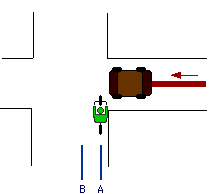 This is one of the most common ways to get hit
(or almost get hit). A car is pulling out of a side street,
parking lot, or driveway on the right. Notice that there are
actually two possible kinds of collisions here: Either you're in
front of the car and the car hits you, or the car pulls out in
front of you and you slam into it.
This is one of the most common ways to get hit
(or almost get hit). A car is pulling out of a side street,
parking lot, or driveway on the right. Notice that there are
actually two possible kinds of collisions here: Either you're in
front of the car and the car hits you, or the car pulls out in
front of you and you slam into it.
How to avoid this collision:
1. Get a headlight. If you're riding at night, you should absolutely use a front headlight. It's required by law, anyway. Even for daytime riding, a bright white light that has a flashing mode can make you more visible to motorists who might otherwise Right Cross you. Look for the new LED headlights which last ten times as long on a set of batteries as old-style lights. And helmet- or head-mounted lights are the best, because then you can look directly at the driver to make sure they see your light.
2. Honk. Get a loud horn and USE IT whenever you see a car approaching (or waiting) ahead of you and to the right. If you don't have a horn, then yell "Hey!" You may feel awkward honking or yelling, but it's better to be embarrassed than to get hit. Incidentally, the UK requires bells on bicycles.
3. Slow down. If you can't make eye contact with the driver (especially at night), slow down so much that you're able to completely stop if you have to. Sure, it's inconvenient, but it beats getting hit. Doing this has saved my life on too many occasions to count.
4. Ride further left. Notice the two blue lines "A" and "B" in the diagram. You're probably used to riding in "A", very close to the curb, because you're worried about being hit from behind. But take a look at the car. When that motorist is looking down the road for traffic, he's not looking in the bike lane or the area closest to the curb; he's looking in the MIDDLE of the lane, for other cars. The farther left you are (such as in "B"), the more likely the driver will see you. There's an added bonus here: if the motorist doesn't see you and starts pulling out, you may be able to go even FARTHER left, or may be able to speed up and get out of the way before impact, or roll onto their hood as they slam on their brakes. In short, it gives you some options. Because if you stay all the way to the right and they pull out, your only "option" may be to run right into the driver's side door. Using this method has saved me on three occasions in which a motorist ran into me and I wasn't hurt, and in which I definitely would have slammed into the driver's side door had I not moved left.
Of course, there's a tradeoff. Riding to the far right makes you invisible to the motorists ahead of you at intersections, but riding to the left makes you more vulnerable to the cars behind you. Your actual lane position may vary depending on how wide the street is, how many cars there are, how fast and how close they pass you, and how far you are from the next intersection. On fast roadways with few cross streets, you'll ride farther to the right, and on slow roads with many cross streets, you'll ride farther left.
| CollisionType #2: | The Door Prize |
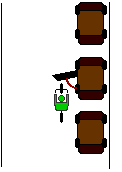 A driver opens his door right in front of you.
You run right into it if you can't stop in time. If you're
lucky, the motorist will exit the car before you hit the door, so
you'll at least have the pleasure of smashing them too when you
crash, and their soft flesh will cushion your impact. One
advocate has compiled a list of cyclists
killed by running into open car doors.
A driver opens his door right in front of you.
You run right into it if you can't stop in time. If you're
lucky, the motorist will exit the car before you hit the door, so
you'll at least have the pleasure of smashing them too when you
crash, and their soft flesh will cushion your impact. One
advocate has compiled a list of cyclists
killed by running into open car doors.
How to avoid this collision:
Ride to the left. Ride far enough to the left that you won't run into any door that's opened unexpectedly. You may be wary about riding so far into the lane that cars can't pass you easily, but you're MUCH more likely to get doored by a parked car if you ride too close to it than you are to get hit from behind by a car which can clearly see you.
| Collision Type #3: | Red Light of Death |
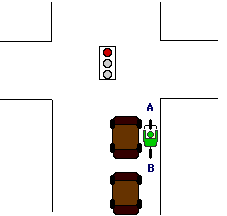 You stop to the right of a car that's already
waiting at a red light or stop sign. They can't see you. When the
light turns green, you move forward, and then they turn right,
right into you. Even small cars can do you in this way, but
this scenario is especially dangerous when it's a bus or a semi
that you're stopping next to. An Austin cyclist was killed in
1994 when he stopped to the right of a semi, and then it turned
right. He was crushed under its wheels.
You stop to the right of a car that's already
waiting at a red light or stop sign. They can't see you. When the
light turns green, you move forward, and then they turn right,
right into you. Even small cars can do you in this way, but
this scenario is especially dangerous when it's a bus or a semi
that you're stopping next to. An Austin cyclist was killed in
1994 when he stopped to the right of a semi, and then it turned
right. He was crushed under its wheels.
How to avoid this collision:
Don't stop in the blind spot. Simply stop BEHIND a car, instead of to the right of it, as per the diagram below. This makes you very visible to traffic on all sides. It's impossible for the car behind you to avoid seeing you when you're right in front of it.
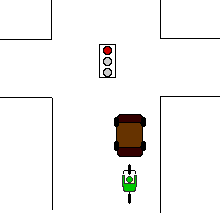 Another option
is to stop at either point A in the diagram above (where the
first driver can see you), or at point B, behind the first car so
it can't turn into you, and far enough ahead of the second car so
that the second driver can see you clearly. It does no good to
avoid stopping to the right of the first car if you're going to
make the mistake of stopping to the right of the second car.
EITHER car can do you in.
Another option
is to stop at either point A in the diagram above (where the
first driver can see you), or at point B, behind the first car so
it can't turn into you, and far enough ahead of the second car so
that the second driver can see you clearly. It does no good to
avoid stopping to the right of the first car if you're going to
make the mistake of stopping to the right of the second car.
EITHER car can do you in.
If you chose spot A, then ride quickly to cross the street as soon as the light turns green. Don't look at the motorist to see if they want to go ahead and turn. If you're in spot A and they want to turn, then you're in their way. Why did you take spot A if you weren't eager to cross the street when you could? When the light turns green, just go, and go quickly. (But make sure cars aren't running the red light on the cross street, of course.)
If you chose spot B, then when the light turns green, DON'T pass the car in front of you -- stay behind it, because it might turn right at any second. If it doesn't make a right turn right away, it may turn right into a driveway or parking lot unexpectedly at any point. Don't count on drivers to signal! They don't. Assume that a car can turn right at any time. (NEVER pass a car on the right!) But try to stay ahead of the car behind you until you're through the intersection, because otherwise they might try to cut you off as they turn right.
While we're not advocating running red lights, notice it is in fact safer to run the red light if there's no cross traffic, than it is to wait legally at the red light directly to the right of a car, only to have it make a right turn right into you when the light turns green. The moral here is not that you should break the law, but that you can easily get hurt even if you follow the law.
By the way, be very careful when passing stopped cars on the right as you approach a red light. You run the risk of getting doored by a passenger exiting the car on the right side, or hit by a car that unexpectedly decides to pull into a parking space on the right side of the street.
| Collision Type #4: | The Right Hook |
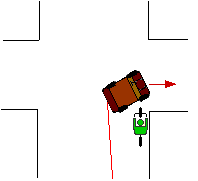 A car passes you and then tries to make a
right turn directly in front of you, or right into you. They
think you're not going very fast just because you're on a
bicycle, so it never occurs to them that they can't pass you in
time. Even if you have to slam on your brakes to avoid hitting
them, they often won't feel they've done anything wrong. This
kind of collision is very hard to avoid because you typically
don't see it until the last second, and because there's nowhere
for you to go when it happens.
A car passes you and then tries to make a
right turn directly in front of you, or right into you. They
think you're not going very fast just because you're on a
bicycle, so it never occurs to them that they can't pass you in
time. Even if you have to slam on your brakes to avoid hitting
them, they often won't feel they've done anything wrong. This
kind of collision is very hard to avoid because you typically
don't see it until the last second, and because there's nowhere
for you to go when it happens.
How to avoid this collision:
1. Don't ride on the sidewalk. When you come off the sidewalk to cross the street you're invisible to motorists. You're just begging to be hit if you do this. Keith Vick was killed this way in Austin, TX in Dec. 2002.
2. Ride to the left. Taking up the whole lane makes it harder for drivers to pass you to cut you off or turn into you. Don't feel bad about taking the lane: if motorists didn't threaten your life by turning in front of or into you or passing you too closely, then you wouldn't have to. If the lane you're in isn't wide enough for cars to pass you safely, then you should be taking the whole lane anyway. Lane position is discussed in more detail below.
3. Glance in your mirror before approaching an intersection. (If you don't have a handlebar or helmet mirror, get one now.) Be sure to look in your mirror well before you get to the intersection. When you're actually going through an intersection, you'll need to be paying very close attention to what's in front of you.
| Collision Type #5: | The Right Hook, Pt. 2 |
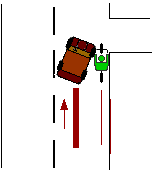 You're passing a slow-moving car (or even
another bike) on the right, when it unexpectedly makes a right
turn right into you, trying to get to a parking lot,driveway or
side street.
You're passing a slow-moving car (or even
another bike) on the right, when it unexpectedly makes a right
turn right into you, trying to get to a parking lot,driveway or
side street.
How to avoid this collision:
1. Don't pass on the right. This collision is very easy to avoid. Just don't pass any vehicle on the right. If a car ahead of you is going only 10 mph, then you slow down, too, behind it. It will eventually start moving faster. If it doesn't, pass on the left when it's safe to do so.
When passing cyclists on the left, announce "on your left" before you start passing, so they don't suddenly move left into you. (Of course, they're much less likely to suddenly move left without looking, where they could be hit by traffic, then to suddenly move right, into a destination.) If they're riding too far to the left for you to pass safely on the left, then announce "on your right" before passing on the right.
If several cars are stopped at a light, then you can try passing on the right cautiously. Remember that someone can fling open the passenger door unexpectedly as they exit the car. Also remember that if you pass on the right and traffic starts moving again unexpectedly, you may suffer #3, the Red Light of Death.
Note that when you're tailing a slow-moving vehicle, ride behind it, not in its blind spot immediately to the right of it. Even if you're not passing a car on the right, you could still run into it if it turns right while you're right next to it. Give yourself enough room to brake if it turns.
2. Look behind you before turning right. Here's your opportunity to avoid hitting cyclists who violate tip #1 above and try to pass you on the right. Look behind you before making a right-hand turn to make sure a bike isn't trying to pass you. (Also remember that they could be coming up from behind you on the sidewalk while you're on the street.) Even if it's the other cyclist's fault for trying to pass you on the right when you make a right turn and have them slam into you, it won't hurt any less when they hit you.
| Collision Type #6: | The Left Cross |
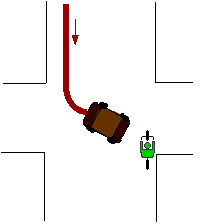 A car coming towards you makes a left turn
right in front of you, or right into you. This is similar to #1,
above. Austin cyclists hit this way include Dr.
Lee Chilton, John
Howell (former
president of the Austin Cycling Association), and Janne
Osborne.
A car coming towards you makes a left turn
right in front of you, or right into you. This is similar to #1,
above. Austin cyclists hit this way include Dr.
Lee Chilton, John
Howell (former
president of the Austin Cycling Association), and Janne
Osborne.
How to avoid this collision:
1. Don't ride on the sidewalk. When you come off the sidewalk to cross the street, you're invisible to turning motorists.
2. Get a headlight. If you're riding at night, you should absolutely use a front headlight. It's required by law in most countries, anyway.
3. Wear something bright, even during the day. It may seem silly, but bikes are small and easy to see through even during the day. Yellow or orange reflective vests really make a big difference. Reflective leg bands are also easy and inexpensive.
4. Don't pass on the right. Don't overtake slow-moving vehicles on the right. Doing so makes you invisible to left-turning motorists at intersections. Passing on the right means that the vehicle you're passing could also make a right turn right into you, too.
5. Slow down. If you can't make eye contact with the driver (especially at night), slow down so much that you're able to completely stop if you have to. Sure, it's inconvenient, but it beats getting hit.
| Collision Type #7: | The Rear End |
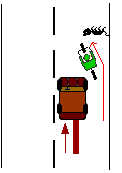
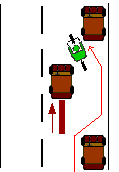 You innocently move a little to the left to go
around a parked car or some other obstruction in the road, and
you get nailed by a car coming up from behind.
You innocently move a little to the left to go
around a parked car or some other obstruction in the road, and
you get nailed by a car coming up from behind.
How to avoid this collision:
1. Never, ever move left without looking behind you first. Some motorists like to pass cyclists within mere inches, so moving even a tiny bit to the left unexpectedly could put you in the path of a car. Practice holding a straight line while looking over your shoulder until you can do it perfectly. Most new cyclists tend to move left when they look behind them, which of course can be disastrous.
2. Don't swerve in and out of the parking lane if it contains any parked cars. You might be tempted to ride in the parking lane where there are no parked cars, dipping back into the traffic lane when you encounter a parked car. This puts you at risk for getting nailed from behind. Instead, ride a steady, straight line in the traffic lane.
3. Use a mirror. If you don't have one, go to a bike shop and get one now. There are models that fit on your handlebars, helmet, or glasses, as you prefer. You should always physically look back over your shoulder before moving left, but having a mirror still helps you monitor traffic without constantly having to look behind you.
| Collision Type #8: | The Rear End, Pt. 2 |
 A car runs into you from behind. This is what
many cyclists fear the most, but it's not the most common kind of
accident (except maybe at night, or on long-distance rides
outside the city). However, it's one of the hardest collisions to
avoid, since you're not usually looking behind you. The best
way to avoid this one is to ride on very wide roads or in bike
lanes, or on roads where the traffic moves slowly. Austin
cyclists Tom
Churchill and Andrew
Turner, and probably William
Sigtryggsson died this way. All three of these incidents happened
at night, and at least two of them didn't have lights. Getting
rear-ended in the daylight is rare.
A car runs into you from behind. This is what
many cyclists fear the most, but it's not the most common kind of
accident (except maybe at night, or on long-distance rides
outside the city). However, it's one of the hardest collisions to
avoid, since you're not usually looking behind you. The best
way to avoid this one is to ride on very wide roads or in bike
lanes, or on roads where the traffic moves slowly. Austin
cyclists Tom
Churchill and Andrew
Turner, and probably William
Sigtryggsson died this way. All three of these incidents happened
at night, and at least two of them didn't have lights. Getting
rear-ended in the daylight is rare.
How to avoid this collision:
1. Get a rear light. If you're riding at night, you absolutely should use a flashing red rear light. Bruce Mackey (formerly of Florida, now head of bike safety in Nevada) says that 60% of bike collisions in Florida are caused by cyclists riding at night without lights. In 1999, 39% of deaths on bicycles nationwide occurred between 6 p.m. and midnight. [USA Today, 10-22-01, attributed to the Insurance Institute for highway safety]
Bike shops have red rear blinkies for $15 or less. These kind of lights typically take two AA batteries, which last for months (something like 200 hours). I can't stress this item enough: If you ride at night, get a rear light!
2. Wear a reflective vest or a safety triangle. High quality reflective gear makes you a lot more visible even in the day time, not just at night. I had a friend ride away from me while wearing one during the day, and when she was about a quarter mile away, I couldn't see her or her bike at all, but the vest was clearly visible. At night the difference is even greater. Bike shops have vests and triangles for $10 to $15. Also, when you hear a motorist approaching, straightening up into a vertical position will make your reflective gear more noticeable.
3. Choose wide streets. Ride on streets whose outside lane is so wide that it can easily fit a car and a bike side by side. That way a car may zoom by you and avoid hitting you, even if they didn't see you!
4. Choose slow streets. The slower a car is going, the more time the driver has to see you. I navigate the city by going through neighborhoods. Learn how to do this.
5. Use back streets on weekends. The risk of riding on Friday or Saturday night is much greater than riding on other nights because all the drunks are out driving around. If you do ride on a weekend night, make sure to take neighborhood streets rather than arterials.
6. Get a mirror. Get a mirror and use it. If it looks like a car doesn't see you, hop off your bike and onto the sidewalk. Mirrors cost $5-15. Trust me, once you've ridden a mirror for a while, you'll wonder how you got along without it. My paranoia went down 80% after I got a mirror. If you're not convinced, after you've used your mirror for a month, take it off your bike and ride around and notice how you keep glancing down to where your mirror was, and notice how unsafe you feel without it.
7. Don't hug the curb. This is counter-intuitive, but give yourself a little space between yourself and the curb. That gives you some room to move into in case you see a large vehicle in your mirror approaching without moving over far enough to avoid you. Also, when you hug the curb tightly you're more likely to suffer a right cross from motorists who can't see you.
| Collision Type #9: | The Crosswalk Slam |
 You're riding on the sidewalk and cross the
street at a crosswalk, and a car makes a right turn, right into
you. Cars aren't expecting bikes in the crosswalk, so you
have to be VERY careful to avoid this one. Devorah
Feldman was
hit in this type of collision, suffering permanent injuries. This
collision is so common we've lost track of the number of people
who've told us they were hit this way, such as Ray
John Ray.
You're riding on the sidewalk and cross the
street at a crosswalk, and a car makes a right turn, right into
you. Cars aren't expecting bikes in the crosswalk, so you
have to be VERY careful to avoid this one. Devorah
Feldman was
hit in this type of collision, suffering permanent injuries. This
collision is so common we've lost track of the number of people
who've told us they were hit this way, such as Ray
John Ray.
How to avoid this collision:
1. Get a headlight. If you're riding at night, you should absolutely use a front headlight. It's required by law, anyway.
2. Slow down. Slow down enough that you're able to completely stop if necessary.
3. Don't ride on the sidewalk in the first place. Crossing between sidewalks can be a fairly dangerous maneuver. If you do it on the left-hand side of the street, you risk getting slammed as per the diagram. If you do it on the right-hand side of the street, you risk getting slammed by a car behind you that's turning right. You also risk getting hit by cars pulling out of parking lots or driveways. These kinds of accidents are hard to avoid, which is a compelling reason to not ride on the sidewalk in the first place.
And another reason not to ride on the sidewalk is that you're threatening to pedestrians. Your bike is as threatening to a pedestrian as a car is threatening to you. Finally, riding on the sidewalk is illegal in some places. (In Austin, those places are the Drag, and downtown on 6th St. and on Congress). If you do plan on riding on sidewalks, do it slowly and EXTRA carefully, ESPECIALLY when crossing the street between two sidewalks.
| Collision Type #10: | The Wrong-Way Wallop |
 You're riding the wrong way (against traffic,
on the left-hand side of the street). A car makes a right turn
from a side street, driveway, or parking lot, right into you.
They didn't see you because they were looking for traffic only on
their left, not on their right. They had no reason to expect that
someone would be coming at them from the wrong direction.
You're riding the wrong way (against traffic,
on the left-hand side of the street). A car makes a right turn
from a side street, driveway, or parking lot, right into you.
They didn't see you because they were looking for traffic only on
their left, not on their right. They had no reason to expect that
someone would be coming at them from the wrong direction.
Even worse, you could be hit by a car on the same road coming at you from straight ahead of you. They had less time to see you and take evasive action because they're approaching you faster than normal (because you're going towards them rather than away from them). And if they hit you, it's going to be much more forceful impact, for the same reason. (Both your and their velocities are combined.)
How to avoid this collision:
Don't ride against traffic. Ride with traffic, in the same direction.
Riding against traffic may seem like a good idea because you can see the cars that are passing you, but it's not. Here's why:
There's one possible exception to riding the wrong way. When you're riding in the country on narrow, high-speed roads, it may be helpful to ride against traffic so you can see what you're up against. Compared to city traffic, country traffic is likely to have less roadspace for bikes and cars to share. That being the case, riding the wrong way allows you to bail into the shoulder if a car doesn't see you. You don't have problem #1 above because side traffic is rare, and #2 is avoided because you're riding primarily along one road and not turning right.
Country traffic is more likely to be sparse, which means that you may have the ability to switch to the "correct" side of the road when a car approaches you from ahead. I did a 100-mile ride with a friend once, continually switching from the left-hand side of the road to the right-hand side depending on whether traffic was approaching us from ahead or behind, since a vehicle passed us only once every several minutes -- but when it passed us, it was doing 70mph+, and we wanted to be as far away from it as we could. But remember that vehicles will still approach you faster when you ride the wrong way, and it's still illegal. It's your choice.
More General Tips |
| Avoid
busy streets. One of the biggest mistakes that people make when they start biking is to take the exact same routes they used when they were driving. It's usually better to take the streets with fewer and slower cars. Sure, cyclists have a right to the road, but that's a small consolation when you're dead. Consider how far you can take this strategy: If you learn your routes well, you'll find that in many cities you can travel through neighborhoods to get to most places, only crossing the busiest streets rather than traveling on them. Light up. Too obvious? Well, if it's so obvious, then why do most night-time cyclists ride without lights? Bike shops have rear red blinkies for $15 or less. Headlights are just as important as rear lights. Look for the new kind with LED's since they last ten times as long on a set of batteries as old-style lights. Take the whole lane when appropriate. It's often safer to take the whole lane, or at least ride a little bit to the left, rather than hug the right curb. Here's why:
You might worry about slowing down the traffic behind you if you take the lane. But if you're on the kind of street where you've got cars blocked up behind you or constantly changing lanes to get around you, you're probably on the wrong street and should find a quieter neighborhood street. Taking the lane works especially well in most traffic circles. The traffic generally moves slower so it's easy to keep up, riding in the lane makes you more visible to motorists, and taking the lane prevents motorists from right hooking you as they exit the circle. It's perfectly legal for you to take the lane when appropriate. Texas State Law (and the laws of most other states) says you have to ride as far to the right as is "practicable". Here are some things that make it impracticable to ride to the extreme right:
There are risks to both riding to the extreme right as well as taking the lane. Whether you ride to the right or take the lane depends on the conditions of the roadway you're on. On wide roadways with slow traffic and few intersections/driveways, right further right. One fast roadways with lots of traffic and intersections, ride farther to the left. It's not always better to take the lane or to hug the curb; it depends on the roadway you're on. |
Ride
as if you were invisible. It's often helpful to ride in such a way that motorists won't hit you even if they don't see you. You're not trying to BE invisible, you're trying to make it irrelevant whether cars see you or not. If you ride in such a way that a car has to see you to take action to avoid hitting you (e.g., by their slowing down or changing lanes), then that means they will definitely hit you if they don't see you. But if you stay out of their way, then you won't get hit even if they didn't notice you were there. On very fast roads cars have less time to see you because they're approaching so fast. Of course, you should avoid fast roads in the first place if at all possible, unless there's plenty of room for a car and a bike side by side. And if there IS such room, then on fast roadways, you can practice invisibility by riding to the extreme right. If you're far enough right that you're not in the part of the lane the cars are in, then they'll zoom by and won't hit you, even if they never saw you. Here's another example: It's a good idea to signal a left turn, but it's a better idea to make your left turn at a time or place where there aren't cars behind you that could hit you while you're stopped and waiting to make that turn. You can hang out in the middle of the street, stopped, with your left arm out, waiting to make your turn, but you're counting on cars behind you to see you and stop. If they don't see you, you're in trouble. Naturally we don't advocate running red lights, but if you're the kind of person who does, then apply the invisibility principle when deciding on whether to run a particular light: Could any cross traffic possibly hit me if I were invisible? If yes, then absolutely don't do it. Never make a car have to slow down to avoid hitting you (red light or not). Remember, the more you rely on cars to see you to avoid hitting you, the more chances they'll have to actually do so. Remember, you're not trying to BE invisible, you're just riding with the assumption that cars can't see you. Of course, you certainly want them to see you, and you should help them with that. That's why you'll wave to motorists whom you think might be about to pull out in front of you, and why you'll be lit up like a Christmas tree at night (front and rear lights). Remember that in many cases you'll need to take the
lane, in which case you're counting on motorists to see
you. |
Home Astronomy Bicycle Construction Laser Moonbounce Software Guest Misc Sales